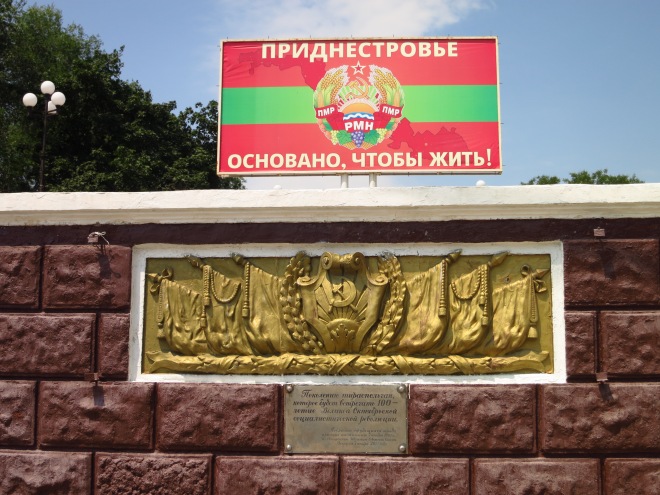Taiwan has long bemoaned its lack of recognition by the rest of the world, but it’s a long, long way ahead of places such as Somaliland (a de facto sovereign state which has just one embassy, in neighbouring Ethiopia), or Kurdistan (an autonomous region of Iraq which welcomes tourists and, unlike the remainder of that sad country, is quite safe).
And then there’s Transdniestr, a ‘country’ which has its own president, government, its own currency, its own police force and army, and maintains border controls with neighbouring Ukraine and Moldova. Yet not one country in the world recognizes it as a separate state. In fact to the rest of the world it’s the easternmost part of Moldova, one of the most obscure ex Russian republics, and itself a country that I’m ashamed to say I’d never heard of until I started researching this summer’s big trip, to Ukraine and the Balkan peninsula.
These days Moldova is quite a popular destination among backpackers in the area – most Western nationalities (save the Aussies and New Zealanders) don’t need a visa, and it exists in a fascinating twilight zone, not quite Russian, and yet certainly not European either. Plus it’s always fun to say you’ve visited a country that most people have never even heard of!
The reason most backpackers make it to Moldova though is cross into Transdniestr, which is billed as one of the last remaining pure communist states, and seems to have become something of a traveller’s rite of passage in recent years. To this day the Eastern European forums of the Lonely Planet Thorn Tree and Trip Advisor are dotted with notes from travellers eager to find out how to enter this rogue state, from those who say it’s not worth the risk, and from travellers who have been and offer tips and encouragement for those interested in going.
In the past, the challenge of getting into Transdniestr seems to have been one of its main drawcards for adventurous travellers, yet these days this once suspicious and mysterious place seems to have turned into something of a paper tiger. The most recent edition of the Lonely Planet Eastern Europe guide still maintains that a visit to Transdniestr is liable to be fraught with hassles, especially at the border, but the sad truth is that adventures here (especially with the famously corrupt border guards) seem to be a thing of the past. Sailing in on the bus from Chisinau (the Moldovan capital), I arrived at the Transdniestrian border (there’s no Moldovan border control, for the simple reason that Moldova still regards Transdniestr as part of its territory) and I was admitted without any dramatic confrontations or financial negotiations. The border guard even spoke a few words of English.
Getting into Transdniestr might no longer generate any interesting traveler’s tales (unless you want to stay more than the visa-free 24 hours, in which case you’ll subject yourself to a whole load of paperwork and other hassles), but the country itself, in its subtle way, is quite remarkable. The state gained its ‘independence’ in 1990, resulting in a war with Moldova two years later, but although an uneasy peace has been kept in the 21 years since, the Transdniestrians seem to be prepared for invasion at any time. The most startling sight of the short drive from the border (2 hours from Chisinau) into the ‘capital’ Tiraspol, is an army stronghold, covered in camouflage netting and guarded by armed soldiers, at the western end of the long bridge crossing the wide Dniestr River, in the town of Bender, 30 minutes from Tiraspol city center, strongly reminiscent of the army bunkers on main roads in Kinmen back in Taiwan, that could still be seen during the tense years after the island first opened to tourism in the late 1990s.
By contrast Tiraspol City itself seems at first a remarkably calm, comfortable, prosperous kind of place, with wide, tree-lined streets, well-dressed locals that seem to be doing well for themselves, and lots of greenery. However look down the far end of the city’s main drag, Ul 25 Oktober, and a whole cluster of sights that can only been seen in the old Russia spring up before the eyes – Social-realist-style murals on the walls extolling the virtues of comradeship, brightly coloured Soviet signs plastered with Cyrillc (Moldova uses the Roman alphabet), a Soviet tank mounted on a plinth, and a large and severe memorial to the dead of the civil war, with an exotic-looking onion-domed chapel, a star-shaped eternal flame, tombstones standing in formation like rows of soldiers, and a sturdy ‘mother Russia’ statue at the head, pouring out her grief over the legions of martyrs laid out in front. Across the street, a large statue of a victorious-looking Lenin, complete with waving, Batmanesque cape, lords over the wide street, in front of the suitably intimidating mass of the House of Soviets.
Tiraspol is littered with sights that mark this place as far more Soviet than anywhere I know in either Moldova or Ukraine, the two countries that border Transdniestr, and although its architecture is no match for the severely impressive structures of Bishkek (the unforgettable capital of Kyrgyzstan), Transdniestr, a ‘country’ that almost no-one has heard of, makes for a strange and very memorable day trip.









